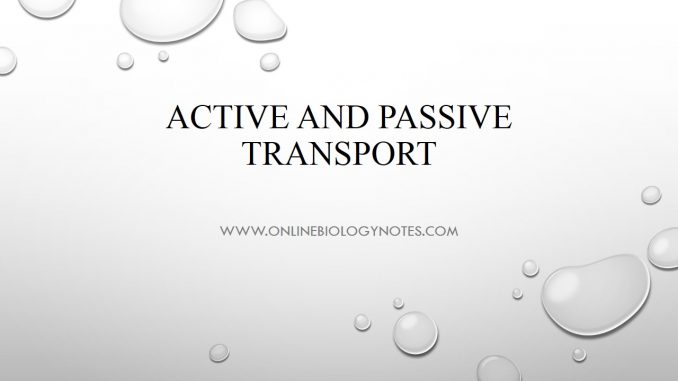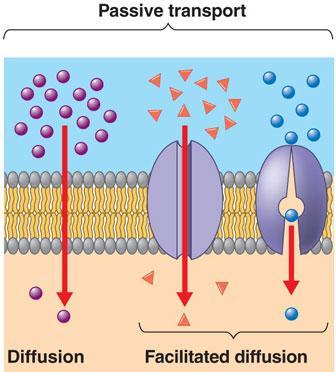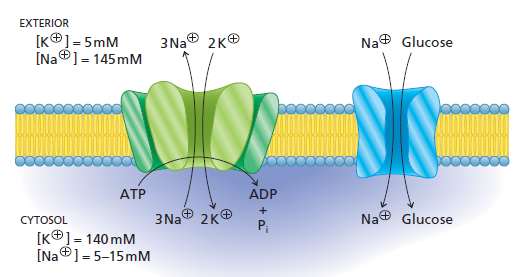
Membrane transport system-Passive and Active transport
Membrane transport system is the transport system by which various molecules enter into and out of cell across cell membrane. Cells have various transport mechanism. Based on whether the molecules pass directly through lipid bilayer or via membrane channel, whether or not the molecules is altered as it passes through membrane , whether or not the process require energy, membrane transport system is categorized into two major groups.
- Passive transport
- Active transport
1. Passive transport:
- Passive transport mechanism does not require cellular energy to transport molecules across cell membrane. So it is a passive process.
- In this transport system, molecules are transported from its higher concentration to the lower concentration until concentration gradient is diminished.
- Passive transport does not work against concentration gradient.

- Passive transport includes-
i) Simple diffusion or passive diffusion
ii) Osmosis
iii) Facilitated diffusion
i. Simple diffusion:
- Simple diffusion is the transport or movement of molecules from higher concentration to lower concentration without expenditure of energy.
- In this process, molecules simply diffuses through the pore of cell membrane.
- Simple diffusion do not require transporter protein.
- When the concentration of molecules is different inside and outside of the cell membrane, concentration gradient is established. Then the molecules moves from higher concentration to lower concentration until equilibrium is maintained.
- When the concentration of molecules becomes equal on both side of the membrane, transport process stops.
- In some case, the molecules after entering the cell transform metabolically, preventing to build up concentration of transported molecules, hence the concentration gradient remain established.
- The rate of diffusion is determined by concentration gradient and permeability of cytoplasmic membrane.
- Greater the concentration gradient and permeability of the cell membrane, greater will be the rate of passive diffusion.
- Examples: water or gases enter the bacterial cell by simple diffusion.
ii. Osmosis:
- The movement of solvent (water) across membrane in response to the concentration gradient of solute is known as Osmosis.
- Bacterial cytoplasm have generally higher solute concentration than its surrounding.
- There are 3 types of solution based on comparison to the bacterial cytoplasmic concentration.
- In isotonic solution, water move equally in both direction inside and outside of cell.
- In hypertonic solution, water moves out of the cell so that cell shrinks. The process is known as plasmolysis.
- In hypotonic solution, water moves inside the cell so that cell swells up. The process is known as plasmotysis.
iii. Facilitated diffusion:
- The process of facilitated diffusion is similar to simple diffusion as the molecules flows from higher concentration to lower concentration but it is different from simple diffusion because it requires transporter protein for the process.
- The transporter protein is known as Permease or Porter or carrier protein.
- The transporter protein are specific however some can transport multiple compounds.
- At first solute molecule binds with the transporter protein and changes the 3D structure of the transporter protein and this change in shape allows the solute to carried across the membrane.
2. Active transport:
- Active transport requires transporter protein and continuous supply of cellular energy for the transport of molecules across concentration gradient of the membrane.
- Active transport is very important to transport the molecules which are present in very low concentration in the medium.
- In active transport permease or transporter protein carries the molecules across the membrane and the energy required to transport is obtained by ATP or Ion gradient.
- The substances transported by active transport are glucose, aminoacids, organic acids and inorganic ions (SO4–, PO4–, K+ etc).
- Examples: Lac operon (transport of lactose in E. coli), Na-K pump

- Active transport system includes-
i) Primary active transport
ii) Secondary active transport
i. Primary active transport:
- In primary active transport, hydrolysis of energy rich molecules such as ATP provide energy required for transport of molecules form lower concentration to higher concentration across membrane.
ii. Secondary active transport:
- In secondary active transport, one type of molecule migrates from higher concentration to lower concentration, releasing energy. This released energy is used to transport other molecule from its lower concentration to higher concentration across cell membrane.
